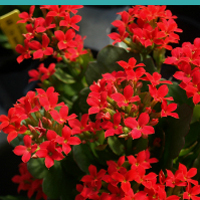| E-mail me at mcclainm@optonline.net | Visit my Facebook page | View my LinkedIn profile |
My Garden Plants
Michael L McClain
St James, NY
Shelter Island, NY
Kalanchoe
Kalanchoe blossfeldiana

Kalanchoe is a flowering houseplant popular during the Christmas season. It has dark green leaves and clustered four petaled flowers. The plant requires little mainenance except watering and fertilizing. With care it an be coaxed into blooming each winter.
"Kalanchoe grows best in full sun and a well-drained potting soil. Kalanchoe will tolerate bright indoor light levels well and tends to get spindly in low light conditions. Kalanchoe can be damaged by over watering. Allow the soil to dry slightly between waterings. Fertilize actively growing plants once a month. Ideal temperatures are 45-65 °F at night and 50-70 °F during the day. Cool night temperatures prolong flower life.
With good care, kalanchoes may be grown to rebloom the next season. After flowering, shift the plant to a slightly larger pot in a well-drained and well- aerated potting soil, such 60% peat moss and 40% perlite. Cut back tall growth and old flower stems. Keep well watered in a sunny, warm window. After danger of frost, move outdoors to a bright, lightly shaded spot for the summer. Gradually adjust them to outdoor conditions, so tender leaves will not burn. Bring back indoors before the first frost or 3 months before desired bloom time.
Kalanchoes, like poinsettias, require short day lengths (long nights) for flower bud development. Natural day lengths between October 1 and March 1 allow flower buds to form. During this time, keep the plant in a room where lights are not turned on during the naturally dark hours or control day length by placing the plant in a closet in late afternoons and then bringing it out to a high light environment each morning. About six weeks of natural winter day lengths are required for flower buds to form. Natural winter day lengths will supply kalanchoe with a 14 to 16-hour night period. After the flower buds are large enough to be seen above the foliage, day length is no longer crucial. At this time, place plants in any location regardless of night lighting. Plants exposed to naturally short day lengths in early October should begin flowering by January (i.e. approximately 12 weeks from start of long nights)."
Wendy bought two Kalanchoes just before Christmas 2017. They are currently in full bloom next to the windows in the north-west corner of the back room of the Red House, where the temperatures are cool and the nights are long and dark. I have probably been overwatering it. When all danger of frost is past, I will move it out to the patio. If it survives, I will bring it back in to the back room to see if we can get it to bloom next year.